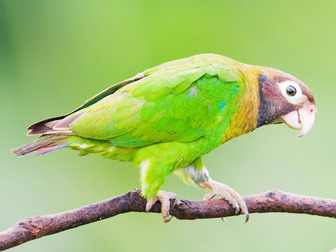Pyrilia haematotis
The Brown-hooded Parrot is a small parrot which is a resident breeding species from southeastern Mexico to north-western Colombia. Until recently, it was placed in the genus Pionopsitta, which now is restricted to the type species, the Pileated Parrot. It is sometimes considered conspecific with the Rose-faced Parrot .

Original source: Eduardo Mariano Rivero (Eduardo Rivero) of ArgentinaPermission(Reusing this file)The permission for use of this work has been archived in the Wikimedia OTRS system.It is available as ticket #2011032210012802 for users with an OTRS account. If you wish to reuse this work elsewhere, please read the instructions at COM:REUSE. If you are a Commons user and wish to confirm the permission, please leave a note at the OTRS noticeboard.Ticket link: https://ticket.wikimedia.org/otrs/index.pl?Action=AgentTicketZoom&TicketNumber=2011032210012802
Author: Eduardo Mariano Rivero (Eduardo Rivero) of ArgentinaPermission(Reusing this file)The permission for use of this work has been archived in the Wikimedia OTRS system.It is available as ticket #2011032210012802 for users with an OTRS account. If you wish to reuse this work elsewhere, please read the instructions at COM:REUSE. If you are a Commons user and wish to confirm the permission, please leave a note at the OTRS noticeboard.Ticket link: https://ticket.wikimedia.org/otrs/index.pl?Action=AgentTicketZoom&TicketNumber=2011032210012802
The Pyrilia haematotis is classified as Least Concern. Does not qualify for a more at risk category. Widespread and abundant taxa are included in this category.
Pyrilia haematotis haematotis (Sclater and Salvin) 203 44. Pyrilia haematotis coccinicollaris (Lawrence) 206 Genus 13. Pionus Wagler 206 Key to the Species of Pionus 208 45. Pionus menstruus (Linnaeus) 210 46. More
Pyrilia haematotis includes subspecies coccinicollaris, which may deserve recognition (Ribas et al. 2005); SACC and NACC do not accept split 42. Amazona xanthops is sister to Graydidascalus (Russello & Amato 2004, Tavares et al. 2006), removed from Amazona to Alipiopsitta (SACC),and English name adjusted(SACC) 43. Pionus seniloides is considered a subspecies of P. More
Pyrilia haematotis haematotis 4. Pyrilia pulchra Forshaw, J.M. & W.T.Cooper (1977). Parrots of the World. T.F.H. Pub., Inc. Neptune, N.J., USA. p. 496 - Links - Arndt, Thomas. Pionopsitta haematotis (Sclater and Salvin 1860) - Brown-hooded Parrot. P.h.haematotis P.h. More
In fact, in Pyrilia haematotis, of our 20 LSUMZ specimens from Costa Rica to Mexico, three show conspicuous red feathers in the belly to varying degrees and a fourth has a hint of reddish coloration there. None has any hint of reddish in the neck, as in coccinicollaris, but the point is that in the sister taxon, red pigmentation shows apparent individual variation. More
* Pyrilia haematotis coccinicollaris (Lawrence) 1862 Ann.Lyc.Nat.Hist.N.Y. 7 p.475 * Pyrilia haematotis haematotis (Sclater,PL & Salvin) 1860 PZS Pt(28)2 p.300 * Pyrilia pulchra (Berlepsch) 1897 Orn.Monatsb. 5 p.175 * Pyrilia barrabandi (Kuhl) 1820 NovaActaAcad.Caes.Leop.Carol. 10 p.61 * Pyrilia barrabandi aurantiigena (Gyldenstolpe) 1951 Ark.Zool. More
Family : Psittacidae
Genus : Pyrilia
Species : haematotis
Authority : (Sclater & Salvin, 1860)
